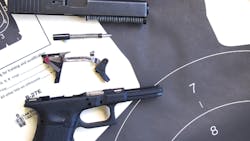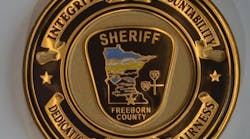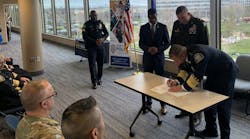We already know what the laser can do on the street. For training, it can do much more.
The laser can predict the strike of the bullet. It is a great tool when an officer is unable to acquire sight alignment because of some mechanical reason. This month, we take a look at the advantages of using lasers as training tools.
In training, the most popular use of a laser is as a diagnostic tool. Instructors cannot efficiently see what the student shooter sees and allow them to assume a “natural” shooting position, complete with sight picture and sight alignment.
There have been some pretty innovative devices designed for instructors to be able to see what the shooter is seeing. For example, there are some two-way mirror devices used to view the sights from the side of the firearm. Unfortunately, they are awkward and don’t allow for anything besides static shooting.
The advantage of using a laser is both the shooter and the coach can see what is going on by viewing the target.
The highest level of laser use for training is a firearms simulator like LaserShot’s PSATS-LE ( Portable Small Arms Training Simulator). This product reinforces basic skills like marksmanship but those higher-level branching for force decision-making. Although the customizable virtual indoor shooting range usually isn’t very portable and often expensive, LaserShot’s PSATS-LE ( Portable Small Arms Training Simulator) can be moved from classroom to classroom, with a little training on the part of the operator. Will the critical operating and targeting equipment is self-contained in a 33 pound package.
Even the less portable products that simulate the recoil of a firearm like the Meggitt Training Systems FATS L7 with tethered simulated weapons are never a substitute for live fire. However, if any agency wants to augment their realism on the range, this is the way to go.
LASERLYTE
One of my favorite tools to have at the range is a LASERLYTE Trainer 22 Caliber - LT-LR. This product is very simple . It is a laser that is installed in the bore of a 22 caliber gun by simply pushing it into the barrel. Only about 1 inch of the product sticks out of the gun. It uses a sound activated switch that momentarily fires a laser when the gun is dry fired, indicating the impact of the bullet.
LASERLYTE released this product about the same time we were experiencing serious 22 caliber ammo shortages. It is a viable method to get good training in a safe area. Why is 22 caliber training being discussed in a law-enforcement magazine? Think about it: 22 caliber is about 5.6 mm. Is there a handgun currently being employed by law enforcement agencies nationwide that is approximately that caliber? The Jeopardy answer is: the FN 5.7. Dozens of agencies have been using the 5.7. Here is the dry fire solution.
LaserLyte®
LT-TTC TRIGGER TYME COMPACT was designed to do exactly as the name implies. The purpose is to give the shooter trigger time, when range time is impractical. The TRIGGER TYME COMPACT guns are detailed and weighted to resemble the real thing. There are two models, one is similar to the Glock 17/22, the other resembles the S&W Shield.
Besides plinking away at the LASER PLINKING CANS : TLB-BWC, one of the best uses for the TRIGGER TYME COMPACT system is to drive home a training concept or task. I would definitely incorporate this product in briefing training.
Laser Ammo
Laser Ammo is a company owned and operated by former Israeli and US military combat veterans. Not only do they offer simple training devices, they have complicated products like high end simulators.
The Shure Strike Laser Training System takes dry fire training to a different level. It uses the Shure strike laser cartridge, a device that actually is placed in the chamber of the firearm. The switch on this product is actuated by the firing pin of the gun.
I combined my experimentation of the Shure Strike Laser Training System with their T0380A Glock Reset Trigger Kit, which is compatible with Glock Gen 3 products. The Laser Ammo Glock Reset trigger allows the shooter to squeeze the trigger repeatedly without having to manipulate the slide.
This simple mechanism is a drop in for the firing mechanism, including the trigger with trigger bar, trigger spring, ejector, connector, and trigger mechanism housing. The kit also includes a special firing pin assembly.
The Glock Reset Trigger/ Shure Strike Laser Training System combination is one of the best methods I have seen for a safe "own gun" training session.
The Laser Ammo system allows an officer to confirm their duty handgun before hitting the streets in a completely safe manner. Once the ShureStrike laser cartridge seats in the chamber, no bullet can take its place. A tube is attached to the cartridge. It extends to the end of the barrel where a fixed chamber flag caps it off. Installed correctly, there is no question in anyone's mind that the gun has been made inert for training. The device fires laser "bullets", meaning the laser only lights momentarily from the strike of the firing pin.
Within reason, the officer can draw from the duty holster, and conduct appropriate training tasks.
The Laser Ammo system can be used for simple target drills. The SureStrike Ultimate LE Edition kit fits in a cargo pocket and it has bushings for 9mm up to .223. When I first started playing with this product, I wondered why the kit came with reflective targets. These are 2.5” reflective squares with various types of targets printed on them. When I fired on them, I thought “Oh, that’s nice. I can stretch out my indoor range a bit because I can see them farther.” I dry fired for about 5 minutes until I jerked the trigger a bit. Instead of a dot, the momentary laser gave me a streak of red, moving from left to right on the reflective target. This phenomenon only occurs if the shooter has a front sight focus and the target is blurry. I started jerking the trigger and incorporating all kinds of shooter errors. Those little reflective targets turned out to be the simplest and most portable diagnostic tools I have used. I have one piece of advice: Don’t create training scars just because it’s interesting.
I recommend The Shure Strike Laser Training System for at home ranges for every officer. This particular product can be incorporated into every level of training and practice. By the way, it can be used on a regular qualification target at regular qualification distances. Obviously, the advantages the ability to use the duty firearm for training.
I got a chance to talk to John Marrs, co-owner and instructor for Spartan Training Resources, and one of our very own writers for Law Enforcement Technology. John told me that they regularly use the SIRT Pistol from Next Level Training. This product is probably one of the most popular laser training devices in the industry right now. It is molded to simulate the feel of the handgun or product it simulates. Most of us get the Glock 17/22 version. It operates in a similar manner, except it has a reset trigger. The SIRT Pistol Comes with a magazine, which increases the number of exercises for which it can be used.
John told me that they encourage their students to dry practice. Dry firing is inherently safe and can be performed anywhere. The SIRT Training Pistol is excellent for students having difficulty with her control. The laser allows an instructor to monitor the students progress.
Spartan Training Rescources does not utilize any specific training drills with a laser. They do, however, spend some time assessing the needs of the student.
John also explained that he’s not a fan of lasers mounted on the gun. When used, marksmanship skills have a tendency to fall away and students become reliant on the laser.
I am a big fan of lasers myself, especially Crimson Trace. These products definitely have their place in law enforcement, specifically at times when the officer would be less likely to acquire a solid sight alignment. I’m very partial to using them behind a ballistic shield.
I picked the brains of Vince Bizzini, owner and lead instructor of Valley Defense Consulting. I have known Vince for years. He was a rangemaster/instructor back when I started my career as a deputy sheriff.
Vince told me that some of his students use lasers. He does not train students to use them because “the red dot is attached to a battery”. He does explain the advantages and disadvantages to his students. A laser allows the shooter to reference the relative position of the muzzle if they can’t get to their sights. Vince explains that the biggest downfall is the fact that students who spend $200-$300 for the products should simply buy ammo and shoot the gun.
A laser, Vince explained, will also give away the location of the gun. This is definitely a consideration in law enforcement.
Valley defense consulting often trains with Next Level Training’s SIRT pistols to teach trigger management.
There you have it. Using the laser can never replace using real bullets. It can, however, augment the department’s goals and diagnose training issues.



